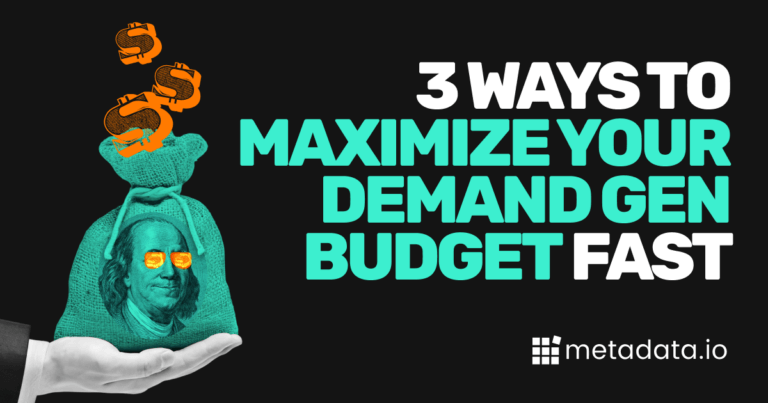Budgeting, Pacing, and Optimizing to Maximize Your Ad Dollars
If I wrote a book about the life of a performance marketer, I’d call it, Metrics, Madness, & Mayhem.
Here are a few of the chapters:
- Burnt out hotkeys for keyboard shortcuts
- OMG, what did I just do!?
- 101 tabs
- There are only 24 hours in a day
- Why am I working on the weekend?
The pressure of performance marketing is VERY real, especially in a down economy. Much of that pressure comes from sky-high expectations—but also the lack of tools to effectively and efficiently launch, manage, and optimize paid campaigns. I’m looking at you, native ad channels.
Performance marketers need help.
Enter Metadata.
The final installment of our Meta with Metadata series dives into how we help performance marketers manage their budgets, pace correctly, and optimize for revenue.
How does Metadata help performance marketers spend on the right stuff?
The average household has access to more than 20 devices, while the run-of-the-mill social media user interacts with 6.6 platforms. This is the norm. It’s why cross-channel and cross-device campaigns are now table stakes.
Here lies the problem: Most B2B marketers attempt to reach buyers using the native ad channels—the same channels that force them to manage their budget at the campaign level (see below). From there, their campaigns branch out into audiences and creatives.

It’s a logical campaign structure and seems like a reasonably tidy way to manage spend. It’s not.
Here lies the second problem: Any semblance of targeting precision is impossible. B2B marketers can only pull levers at the campaign level, giving them no way to identify top-performing audiences and creative. That makes optimization a pipedream (more on that in a minute), but it also completely closes the door to an effective experimentation strategy.
Metadata structures paid campaigns differently.
Instead of forcing B2B marketers to manage their budgets at the campaign level, they can build budget groups, which give them granular insights to make sure they’re spending on the right stuff.
What’s a budget group in Metadata?
Budget groups in Metadata allow B2B marketers to allocate spend toward specific channels (Facebook, LinkedIn, Google, etc.) and goals (demo requests, trials, downloads, etc.).
By managing their campaign at the budget-group level, performance marketers can cast a wider net and identify the tactics and channels driving the most pipeline and revenue.
For example, they can see if MOFU content for a free trial performs better than BOFU content for a demo. They could also see how people in different regions or account lists respond to their ads and shift their spending to get to revenue faster.
Here are a few more examples of budget groups:
Group by funnel stage and offer
- TOFU – Content
- MOFU – Trial
Group by region and offer
- North America – Content
- EMEA – DemoNA – Tier 1 – Content (TOFU)
Group by stage, region, offer, and account list
- EMEA – Tier 1 – Content (TOFU)
- NA – Tier 1 – Trial (MOFU)
That’s a super high-level look, and there’s a level of granularity in these budget groups I won’t get into here, but the message is all the same: Metadata gives B2B marketers a much more granular look at the performance of different channels and tactics. From there, they can manage their budgets in a way that drives the most pipeline and revenue.
How’s pacing different in Metadata?
Remember that chapter, “OMG, what did I do!?” Yeah, that one was about pacing, and here’s my favorite line:
I woke up one morning and realized I had spent my entire budget in 24 hours.
That might be hyperbole, but that degree of pacing misfortune has been known to happen—any performance marketer who’s been in the game long enough knows what I mean.
Consider this media plan:
- Goal: Demos
- Total budget: $100k
- Campaign flight: 90 days
- Daily spend: $1.1k
That daily spent target—$1.1k—is the B2B marketer’s north star for the next 90 days.
It’s up to them to spend as close to that dollar amount every day. That means they have to log into each ad channel every morning, export, and do some voodoo math to see if they’re on track to spend $100k over the next 90 days.
If their campaigns have multiple audiences and creative, which I’m sure they would, they have to divvy that spend based on performance—and it all has to add up to $1.1k.
They have to do this daily and manually across channels. This is time-consuming, but it also opens the door to human error, which makes over- and underspending an all-too-common inevitability.
Metadata takes a “set-it-and-forget-it” approach to pacing. Instead of making B2B marketers break out the spreadsheets and rack their brains, they can simply log into Metadata and quickly see how their campaigns are progressing.
- Red: Bad
- Yellow: Ok
- Green: Good
Metadata also shows B2B marketers expected vs. actual pacing, giving them peace of mind that their campaigns are on track (or heading for derailment). Then, every 48 hours, Metadata automatically takes this pacing data and recalculates it to make sure marketers have the most up-to-date insights on how their campaigns are moving forward.
Optimizing campaigns in Metadata vs. the native channels
Think back (or scroll back) to the part of the article about campaign structure and how budgets sit at the campaign level in native ad channels. This shortcoming makes budget management difficult, but it makes optimizations next to impossible.
Because budgets sit at the campaign level in the native channels, marketers can’t get a variable-level view of performance. They certainly can’t optimize toward the tactics and channels driving the most pipeline and revenue.
Not only that, but the channels exist in siloes. You know, walled gardens—which means Facebook will move money to Facebook, LinkedIn to LinkedIn, and so on. It doesn’t matter if LinkedIn is outperforming Facebook, or Google is one-upping display networks. Each channel’s in it to make money and will only optimize within its walls.
Metadata’s Optimizer is channel agnostic, meaning it’ll move budget to the tactics and channels driving the best return. Metadata doesn’t care which channel or ad gets more spend—it only cares about helping marketers achieve their goals.
Instead of merely optimizing toward leads, which is all that’s possible in the native channels, Metadata allows marketers to optimize to what really matters.
I’m talking about:
- MQL
- SQL
- Cost per MQL
Think of a three-letter abbreviation and marketers can optimize toward it in Metadata. And because they can connect Metadata to their CRM and marketing automation tools, e.g., Salesforce and HubSpot, they can optimize toward the metrics that actually reflect how their ads are driving real-business impact.
Give performance marketers their jobs back
There’s another difference I want to touch on that’s not mentioned on our website. Metadata also helps marketers optimize for work-life balance and their mental health.
Most performance marketers are responsible for thousands upon thousands of dollars, and it’s on them to spend it in the smartest way possible. That comes with late nights, working weekends, and a ton of stress.
Instead of investing time and energy into tasks that actually fit the job description—strategic thinking, ad creative, and brand positioning—performance marketers are left as glorified button-pushers who scramble to budget, pace, and optimize.
Metadata helps alleviate the stress and responsibilities placed on the shoulders of even the most seasoned marketing pros.
Metadata: The smarter way to budget, pace, and optimize your paid campaigns
In summary, Metadata beats optimizers in native ad channels for several reasons:
- It gets rid of data silos
- Marketers can make strategic micro adjustments instead of broad guesses
- It prioritizes the best-performing ads and allocates the budget accordingly
- Marketers get their lives back
All of these point to a very small yet meaningful word: Growth.
Growth is what performance marketing is all about; it’s what companies expect from marketers, even if their budgets are shrinking or the team isn’t growing. Unfortunately, native ad channels aren’t built for that. The manual, time-consuming, and error-prone tasks that come with them tend to snowball into lackluster performance and cash left on the table.
It’s not their fault, though. They’re playing with the cards they’ve been dealt. We built Metadata to change that and get performance marketers back to the job as it was intended to be.


